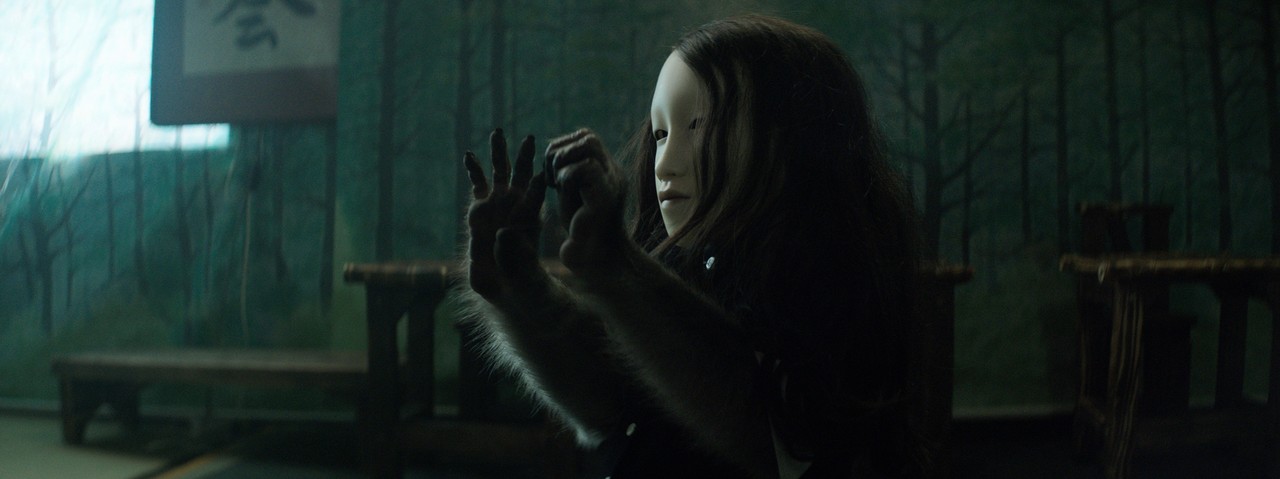Pierre Huyghe
30 Mar - 16 Jul 2017

Pierre Huyghe, (Untitled) Human Mask (2014)
Film, color, stereo sound, 2 min. 66 sec. Running time: 19 min.
Courtesy of the artist and Hauser & Wirth, London, & Anna Lena Films, Paris
© Pierre Huyghe, VEGAP, 2017
Film, color, stereo sound, 2 min. 66 sec. Running time: 19 min.
Courtesy of the artist and Hauser & Wirth, London, & Anna Lena Films, Paris
© Pierre Huyghe, VEGAP, 2017
PIERRE HUYGHE
Untitled (Human Mask)
30 March –16 July 2017
Curator: Manuel Cirauqui
From March 30 to July 16, 2017, the Guggenheim Museum Bilbao will premiere in Spain Pierre Huyghe’s Untitled (Human Mask) (2014). This is the tenth piece presented in the Film & Video Gallery since it opened in 2014 as a showcase for video art, video installations, and the moving image.
Pierre Huyghe (b. Paris, 1962) conceived Untitled (Human Mask) in 2014 after learning about two trained monkeys who served and entertained patrons at a traditional sake house in Japan. Huyghe’s film is shot in a location ravaged by the recent tsunami and ensuing nuclear disaster at Fukushima. A singular inhabitant wanders through a gloomy interior wearing a traditional Japanese theater mask, a woman’s wig, a white shirt, and a dress resembling a school uniform. We soon realize it is a monkey, although the creature’s attentive, anxious attitude and body language suggest an ambiguous humanity. Through this piece, Huyghe reflects on the paradox of observing animal behavior in a surreal setting with the intention of exploring reality—in other words, he reflects on the human condition.
The film opens with a sequence recorded by a drone in a desolate landscape dotted with derelict buildings. Inside one of those abandoned houses, the narrative emerges from the juxtaposition of closeup shots of the ape, whose movements become increasingly agitated. Although the place is deserted, the animal goes about the tasks she was trained to do: she diligently sets out a napkin, serves a bottle to an empty table, and performs the same pirouettes that once made patrons laugh in amazement. And she does this in the midst of a world that is practically destroyed, where the only signs of life are a cat, the cockroaches that scurry around the kitchen, and the maggots in bags of food left open. The female voice emanating from some undisclosed location adds to the tension of the scene, echoing the tsunami warnings issued to alert the population of impending disaster. The lack of expression of the mask further emphasizes the alienation and solitude of the figure, making us wonder about her feelings and emotions.
As in many of his works, Huyghe blurs the boundaries between fiction and reality by using characters that confront us with human nature and the mystery of our own behavior. The monkey looks towards us but cannot see us through her "human mask," while we observe in amazement the behavior of those beings with which we share the world.
Untitled (Human Mask)
30 March –16 July 2017
Curator: Manuel Cirauqui
From March 30 to July 16, 2017, the Guggenheim Museum Bilbao will premiere in Spain Pierre Huyghe’s Untitled (Human Mask) (2014). This is the tenth piece presented in the Film & Video Gallery since it opened in 2014 as a showcase for video art, video installations, and the moving image.
Pierre Huyghe (b. Paris, 1962) conceived Untitled (Human Mask) in 2014 after learning about two trained monkeys who served and entertained patrons at a traditional sake house in Japan. Huyghe’s film is shot in a location ravaged by the recent tsunami and ensuing nuclear disaster at Fukushima. A singular inhabitant wanders through a gloomy interior wearing a traditional Japanese theater mask, a woman’s wig, a white shirt, and a dress resembling a school uniform. We soon realize it is a monkey, although the creature’s attentive, anxious attitude and body language suggest an ambiguous humanity. Through this piece, Huyghe reflects on the paradox of observing animal behavior in a surreal setting with the intention of exploring reality—in other words, he reflects on the human condition.
The film opens with a sequence recorded by a drone in a desolate landscape dotted with derelict buildings. Inside one of those abandoned houses, the narrative emerges from the juxtaposition of closeup shots of the ape, whose movements become increasingly agitated. Although the place is deserted, the animal goes about the tasks she was trained to do: she diligently sets out a napkin, serves a bottle to an empty table, and performs the same pirouettes that once made patrons laugh in amazement. And she does this in the midst of a world that is practically destroyed, where the only signs of life are a cat, the cockroaches that scurry around the kitchen, and the maggots in bags of food left open. The female voice emanating from some undisclosed location adds to the tension of the scene, echoing the tsunami warnings issued to alert the population of impending disaster. The lack of expression of the mask further emphasizes the alienation and solitude of the figure, making us wonder about her feelings and emotions.
As in many of his works, Huyghe blurs the boundaries between fiction and reality by using characters that confront us with human nature and the mystery of our own behavior. The monkey looks towards us but cannot see us through her "human mask," while we observe in amazement the behavior of those beings with which we share the world.
